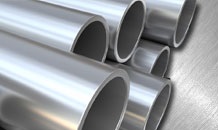Corrosive Resistance in Various Nickel Alloys
The rapid pace of advancement in technology has introduced new approaches to traditional applications. As new systems are developed, and existing systems are upgraded, a variety of nickel based alloys are being used to bring about enhanced performance. For the MRO faced with working with these materials, it is important to first have a good understanding their characteristics and composition.

To get a better understanding of these dynamic materials, including the various methods of welding and machining, let’s take a close look at each one.
Incoloy®
Incoloy®—like inconel and monel—is a line of superalloys produced by the Special Metals Corporation, a group of companies specializing in the invention, production, and distribution of high-performance nickel alloys for specialized engineering projects. Incoloy is an age-hardenable nickel-iron-chromium alloy with additional amounts of copper, aluminum, molybdenum, and titanium. It is designed for superior corrosion resistance and strength at high temperatures.
Incoloy is especially resistant to corrosion in aqueous environments like plumbing systems, pipelines, or marine appliactions. It is capable of maintaining a stable and austenitic structure through protracted periods of exposure to high temperatures. Incoloy alloys—there are currently 22 grades—are typically used for a range of applications including chemical processing, oil and gas well piping, heat exchangers, carburizing equipment, and nuclear facilities.
Incoloy’s general working range of temperatures is 1600°F (850°C) to 2150°F (1175°C). To achieve maximum corrosion resistance and strength after aging, the alloy should be hot-worked in the 1600°F (870°C) to 1800°F (980°C). When cold-formed, incoloy alloy 925 behaves similarly to incoloy 825, except with a higher work-hardening rate.
The recommended materials for welding incoloy 925 is Inco-Weld® filler metal 725NDUR®, which provides stronger material with better corrosion resistance than incoloy 925. For best results, the preferred methods for welding are gus-tungsten-arc welding (GTAW) and gas-metal-arc welding (GMAW). With the latter method, current levels should not go above 180 amps for standard GMAW power sources in the “spray arc” metal transfer mode.
Hastelloy®
Hastelloy® is a proprietary superalloy from Haynes International, Inc. Hastelloy’s primary alloying ingredient is usually transition metal nickel. This is typically added to other metals like iron, copper, titanium, and aluminum to various percentages. Common Hastelloy Grades include C276 and C22.
The greatest advantage of hastelloy is its resistance to high-temperature and high-stress environments, specifically the formation of grain boundary precipitates that result from exposure to high heat. It is known for its potential to survive in severely corrosive or erosion prone scenarios where other, more common iron-based alloys would quickly fail.
Hastelloy is particularly resistant to wet chloride gas, chlorine, and oxidizing salts such as ferric and cupric chlorides. It is typically used in nuclear and chemical reactors, distillation equipment, and pipes and valves in the chemical processing.
There are two types of recommended filler materials for hastelloy: matching and overalloyed. Matching filler material means that the filler material is made of the same chemical composition. Overalloyed filler materials mean non-matching, highly-alloyed, highly corrosion-resistant welding filler material, which reduces the chance of preferential weld metal corrosion attack.
The preferred methods of welding hastelloy are GTAW, GMAW, and shielded metal arc welding (SMAW). Due to the sluggish welding and shallow penetration characteristics of nickel-based alloys, it is important to pay careful attention to joint design and weld bead placement to ensure solid welds with proper weld bead tie-in. It is also recommended to grind starts and stops, since these alloys have a tendency to crater crack.
Inconel®
Inconel® is a superalloy where the primary alloying ingredient is nickel-chromium. It is oxidation and corrosion resistant, especially to chloride-ion stress –corrosion cracking, which makes it well-suited for high pressure and heat environments. This is because when inconel is heated, it forms a thick, stable, passivating oxide layer that protects the surface from additional damage. It’s suited to a wide range of temperatures, which makes it a great alternative to other metals like aluminum or steel which are susceptible to creep.
Inconel currently has 25 grades. Inconel 600, 601, 625, 825, x-750 are some of the more commonly used incoloy alloys. They are typically used for furnace components, chemical and food processing, aerospace and land base gas turbine parts like jet engines, and other extreme-service applications.
Inconel has a tendency to quickly work harden, so it is necessary to machine age-hardened grades like 718 with an aggressive but slow cut with a hard tool to minimize the number of passes. Welding inconel is also difficult since it tends to crack and microstructurally segregate in the heat-affected zone. The most common ways to overcome this is through GTAW and electron beam welding.
Monel®
We’ve previously talked about Monel®, focusing particularly on its high-temperature properties. This superalloy is primarily composed of nickel and copper, with trace amounts of iron, manganese, carbon, and silicon. Monel has excellent corrosion resistance and is stronger than pure nickel. Although it is more difficult to fabricate than steel, its high sulfur content gives it better and enhanced machinability.
Monel is ideal for marine and chemical environments due to its resistance to sea water, hydrofluoric acid, sulfuric acid, and alkalies. It has ASME approval for use in boilers, pressure vessels and nuclear vessels. It is typically used in heat exchangers, oil refinery piping, sulfuric acid plants, nuclear fuel production, and pump shafts.
Unlike inconel, incoloy and hastelloy, monel is relatively easier to machine and weld. In general, it is recommended to use cold-drawn, stress-relieved material for the best machinability and smoothest finish. Similarly, monel can be welded through a wide range of conventional welding methods, including SMAW (best for monel 400), GTAW, and GMAW (best for Monel Filler Metal 60).

